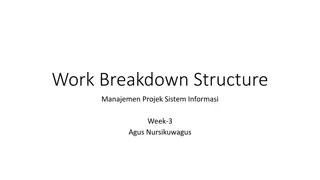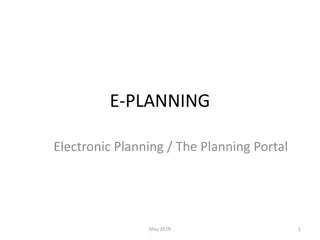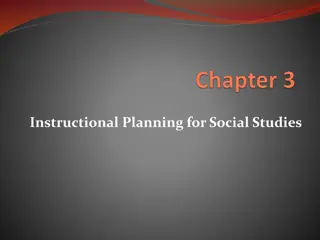PROJECT TIME PLANNING
Planning is essential in determining future goals and strategies for achieving them. Time planning plays a crucial role in completing projects timely and efficiently. This process involves visualizing activities, sequencing them, estimating durations, scheduling, and resource allocation. Time planning is necessary for effective resource management, communication facilitation, progress evaluation, and decision-making. It is crucial for various stakeholders including customers, project teams, financiers, and suppliers to ensure smooth project execution.
Download Presentation

Please find below an Image/Link to download the presentation.
The content on the website is provided AS IS for your information and personal use only. It may not be sold, licensed, or shared on other websites without obtaining consent from the author.If you encounter any issues during the download, it is possible that the publisher has removed the file from their server.
You are allowed to download the files provided on this website for personal or commercial use, subject to the condition that they are used lawfully. All files are the property of their respective owners.
The content on the website is provided AS IS for your information and personal use only. It may not be sold, licensed, or shared on other websites without obtaining consent from the author.
E N D
Presentation Transcript
PROJECT TIME PLANNING Process and Bar Chart Technique
Definition of Planning Planning is the process of thinking systematically about the future in order to decide what our goals are, and how we are going to achieve them. Planning preparations, and deciding the best course of action. means looking ahead, making
Dimensions of Planning Planning can be viewed from following points: Subject:- Time Planning, Quality Planning, Financial Planning, Risk Planning, Product Planning, Organizational Planning, . Organization:- Strategic Planning, Corporate Planning, Project Planning, Time:- Long-Rang Planning, Short-Range Planning, Weekly Planning, .
Why is TimePlanningnecessary? 1) The increasing importance of timely completion. 2) The continuous complexity and growth in the size of the project generates the necessity for specialization. Specialization may lead to a breakdown of communications. Time planning must be found to facilitate communications. 3) Planning is essential for resource management 4) Planning is important for the efficient and maximum utilization of resources.
Why is TimePlanningnecessary? 5) Planning is basis for evaluating progress, controlling the work and making decisions. 6) For achieving an increase in production. 7) Financiers require a workable plan. 8) Essential in projects when their is transfer of personnel. 9)Minimum risk of the problems occurring.
Who Needs Time Planning? Customer/ Client/ Owner Designer/ Consultant Project management team (Manager, Engineers) Cost estimating department Planning and controlling department Supervisors, foremen, labors Supplier Financiers
Processes of Time Planning 1.Visualize and define the activities. (WBS =Work breakdown Structure)) 2.Sequence the activities (Job Logic). 3.Estimate the activity duration. 4.Schedule the project or phase. 5.Allocate and balance resources.
1a) Visualize and define the activities a) An activity is a single work step (element) that has a recognizable beginning and end and requires time for its accomplishment. Activity definition involves identifying and documenting the specific activities that must be performed to produce the deliverables and sub-deliverables.
1b) Visualize and define the activities b) The technique of decomposition (Work Breakdown) may be used in defining activities. Decomposition involves subdividing project work packages into smaller, more manageable components to provide better management control. c) The output from activity definition is the activity list. d) The Level of detail of the plan should be considered in this phase.
1-Visualize and define the activities Work Breakdown Structure (WBS) WBS divides the project into recognizable work packages (tasks and activities) at different levels Level 1. Project 2. Major tasks in the project (work packages) 3. Subtasks in the major tasks 4. Activities to be completed
1-Visualize and define the activities Work Breakdown Structure (WBS) Develop Windows 7 Operating System Level 1 1.0 Software Design Project Management System Testing Level 2 1.3 1.1 1.2 Develop GUIs Module Testing Level 3 Planning 1.1.1 1.2.1 1.3.1 Ensure Compatibility with Earlier Versions Cost/Schedule Management Defect Testing 1.1.2 1.2.2 1.3.2 Compatible with Windows ME Level 4 1.1.2.1 (Work packages) Compatible with Windows Vista (From Heizer/Render: operation Management Figure 3.3 ) 1.1.2.2 Compatible with Windows XP 1.1.2.3
1c) Visualize and define the activities Case Study: Install a new machine Activity Code Activity Description Depends on Level Duration (day) Inspect the machine after installation Hire the operator Install the new machine Inspect and store the machine after delivery Hire labor to install the new machine Train the operator Order and deliver the new machine
2a) Sequence the activities 1.Sequence the activities or job logic refers to identifying and documenting interactivity logical relationships, i.e. determined order in which the activities are to be accomplished in the project.
2b) Sequence the activities 2.Job plan must reflect the practical restraints or limitations that apply to most job activities. The types of restraints are: Mandatory dependencies or hard logic (natural dependency), Preferred logic (Discretionary dependencies), External dependencies, Resource restraints and Safety restraints. 3) Predecessor activities mean coming before, while successor activities mean coming after. 4) Overlap the activities to reduce the project time.
2c) Sequence the activities Case Study: Install a new machine Activity Code 100 Activity Description Depends on 300 Level Duration (day) Inspect the machine after installation 4 200 Hire the operator None 1 300 Install the new machine 500, 400 3 400 Inspect and store the machine after delivery 700 2 500 Hire labor to install the new machine None 1 600 Train the operator 200, 300 4 700 Order and deliver the new machine None 1
3a) Estimate the activity duration 1. Select the time unit (week, day,..) to be used. 2. Use one of the following tools and techniques for estimating the activity duration: Expert judgment Quantitatively based durations Duration of activity (D) = Quantity of work / [Production rate of a crew or equipment * No. of crews]. Where production rate = Quantity produced in unit of time Duration of activity (D) = Quantity of work * Unit rate productivity of a crew or equipment Where unit rate productivity = Time needs to produce one unit of output
3b) Estimate the activity duration Case Study: Install a new machine Activity Code 100 Activity Description Depends on 300 Level Duration (day) 1 Inspect the machine after installation 4 200 Hire the operator None 1 25 300 Install the new machine 500, 400 3 2 400 Inspect and store the machine after delivery 700 2 1 500 Hire labor to install the new machine None 1 20 600 Train the operator 200, 300 4 3 700 Order and deliver the new machine None 1 30
4a) Schedule the Project or Phase Scheduling Defined It is process showing relationship of activities and determining of the project duration time and the project activities starting and finishing timings.
4a) Schedule the Project or Phase Purpose of Scheduling 1. Ensure that all activities are planned for 2. Their order of performance is accounted for 3. The activity time estimates are recorded 4. The overall project time is developed In scheduling we consider the following questions: How long the project is expected to take? When each activity may be scheduled (started and ended)? How resources can be used more proper? What are the critical bottlenecks in the project?
4b) Schedule the Project or Phase Project Scheduling principles Project scheduling is carried out before a project begins. It involves (1) identifying tasks, (2) estimating duration and (3) allocating resources. Once the project is underway, the schedule may need to be revised based on initial progress. This ensures (1) cost estimates and (2) time constraints are maintained at a specific level of quality and scope. The revision is done by creating milestones. Once the project is underway, the schedule may need to be revised based on initial progress. This ensures (1) cost estimates and (2) time constraints are maintained at a specific level of quality and scope.
Time Planning Techniques To schedule the project, the planner needs a Time Planning Technique. Bar Charts and Linked Bar Charts; Network Model (Analysis), either Activity on arrow (AOA), Activity on node (AON), Precedence Diagram Line of Balance; Time-location Diagram.
Project Scheduling (Process &Time) 25 February 2025 22
BAR CHART During World War 1, Henry Gantt developed the Bar chart planning technique. A bar chart graphically describes a project consisting of well-defined activities, the completion of which marks its end. An activity is a task whose performance contributes to completion of the overall project.
BAR CHART All activities are listed in a column at the left side of the diagram. A horizontal time scale extends to the right of the list. A bar presenting each activity is drawn between its corresponding scheduled start and finish times.
Case study: Install a new machine Activity Code 100 Activity Description Depends on 300 Level Duration (day) 1 Inspect the machine after installation 4 200 Hire the operator None 1 25 300 Install the new machine 500, 400 3 2 400 Inspect and store the machine after delivery 700 2 1 500 Hire labor to install the new machine None 1 20 600 Train the operator 200, 300 4 3 700 Order and deliver the new machine None 1 30 Activity Code 1 2 3 4 5 6 7 8 9 10 11 12 13 14 15 16 17 18 19 20 21 22 23 24 25 26 27 28 29 30 31 32 33 34 35 36 200 500 700 400 300 100 600
Case study: Install a new machine Activity Code 100 Activity Description Depends on 300 Level Duration (day) 1 Inspect the machine after installation 4 200 Hire the operator None 1 25 300 Install the new machine 500, 400 3 2 400 Inspect and store the machine after delivery 700 2 1 500 Hire labor to install the new machine None 1 20 600 Train the operator 200, 300 4 3 700 Order and deliver the new machine None 1 30 Activity Code 1 2 3 4 5 6 7 8 9 10 11 12 13 14 15 16 17 18 19 20 21 22 23 24 25 26 27 28 29 30 31 32 33 34 35 36 200 500 700 400 300 100 600
Gantt chart for Service For A Delta Jet Deplaning Baggage claim Container offload Pumping Engine injection water Container offload Main cabin door Aft cabin door Aft, center, forward Loading First-class section Economy section Container/bulk loading Galley/cabin check Receive passengers Aircraft check Loading Boarding Passengers Baggage Fueling Cargo and mail Galley servicing Lavatory servicing Drinking water Cabin cleaning Cargo and mail Flight services Operating crew Baggage Passengers 0 10 20 30 40 Time, Minutes Figure 3.4 (From Heizer/Render; Operation Management
Uses of Bar Chart Planning Technique Showing the order of the different activities Showing when operations should start and finish Checking what labor or equipment are needed and when Checking out delivery dates for materials Explaining to everyone concerned what and when is due to happen Forecasting cash flow During execution, the chart used to control the work
Advantages of Bar Chart Simple graphical form Easy understood for all levels of management Good form of communication.
Limitations of Bar Chart Very cumbersome as the number of activities, increases Logic is not expressed in the diagram (at the initial stage of developing GS) Difficult to use it for forecasting the effects of changes, It is therefore limited as control tool No indication where management attention should be focused Ineffective for project shortening
Planning a custom-written computer project Step 1. List all activities in the plan Task Earliest start Length Type Dependent on... A. High level analysis B. Selection of hardware platform C. Installation and commissioning of hardware Week 0 Week 1 Week 1.2 1 week 1 day 2 weeks Sequential Sequential Parallel A B D. Detailed analysis of core modules Week 1 2 weeks Sequential A E. Detailed analysis of supporting modules Week 3 2 weeks Sequential D F. Programming of core modules G. Programming of supporting modules Week 3 Week 5 2 weeks 3 weeks Sequential Sequential D E H. Quality assurance of core modules Week 5 1 week Sequential F I. Quality assurance of supporting modules J. Core module training K. Development and QA of accounting reporting L. Development and QA of management reporting Week 8 Week 6 Week 5 Week 5 1 week 1 day 1 week 1 week Sequential Parallel Parallel Parallel G C,H E E M. Development of Management Information System N. Detailed training Week 6 Week 9 1 week 1 week Sequential Sequential L I, J, K, M
Planning a custom-written computer project Step 2. Plot the tasks onto the graph paper
Planning a custom-written computer project Step 3. Presenting the analysis
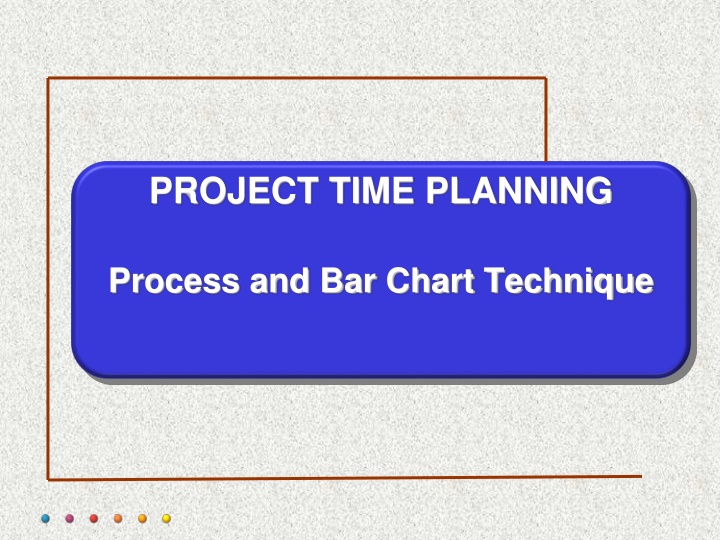





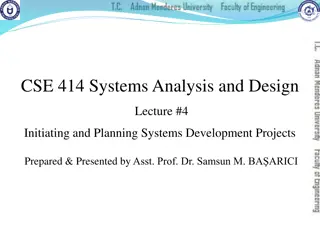





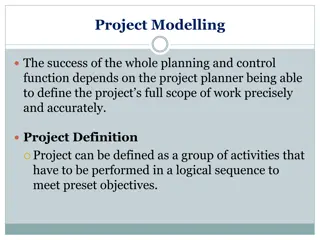


![Project Initiation Document for [Insert.Project.name] [Insert.Project.number]](/thumb/226757/project-initiation-document-for-insert-project-name-insert-project-number.jpg)



